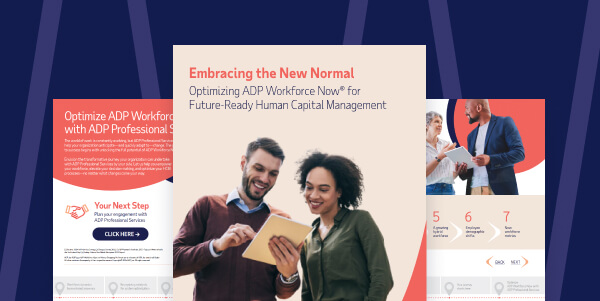Employers who purchase an HRIS for the first time often ask, “Now what?” The answer is implementation – a task that requires much planning. Most reputable software providers include this service with their product, though some have more successful track records than others. Knowing what the process entails can help employers asses if their vendor’s HRIS implementation project plan will have them up and running on their new system quickly and smoothly.
Table of Contents
What is HRIS implementation?
Implementation is how an HRIS is installed and integrated with legacy payroll and HR management systems. Successful deployments of this nature usually require:
- Change management strategies
- Executive sponsors
- Employee communications
- Data migration and configuration
- Project management
- Product training
Why is HRIS implementation important?
A properly executed HRIS implementation helps ensure a smooth transition, improves adoption and maximizes the system’s effectiveness. It should not put undue strain on technical resources. The ideal HRIS provider reduces burdens on IT departments and supports employers throughout the process.
HRIS implementation steps
Whether a company is small, large or somewhere in between, the fundamentals of HRIS implementation remain the same. There are five steps:
- Analyze processes
- Gather data
- Inform third parties
- Secure stakeholder buy-in
- Prepare the infrastructure
Analyzing and documenting HR processes
Employers must first evaluate their current HR operations to identify suboptimal processes and potential refinements. Key considerations include:
- Different employee classifications (exempt vs non-exempt)
- Different pay frequencies
- Reimbursements for expenses, if done through payroll
- Benefits deductions
- Data entry and systems integrations
- Time and attendance policies
- Paid time off (PTO) policies
Gathering data
Legacy payroll and HR data are necessary for implementation. If these records are difficult to obtain, it’s imperative to ensure that the new HRIS will securely store data for the correct lengths of time. Employers must also:
- Review the current data and verify its accuracy.
- Have employees update their personal information.
- Map legacy data transfer to the new system.
Informing third parties
- Benefit providers – Start planning integrations with group health insurance, retirement savings plans, etc.
- Government agencies and unions – Make sure the new HRIS can integrate all applicable regulations and business rules.
- Financial institutions – Notify the banks from which payroll is drawn.
Getting stakeholder buy-in
An HRIS is easier to implement with the full support of employees and company leadership. Here’s how to secure their cooperation:
- Identify stakeholders early and ensure they have time to work on the implementation.
- Establish good communication between project leaders and set expectations and deadlines.
- Schedule training for HR administrators and employees who will use the new HRIS.
Preparing the infrastructure
Employers must assess whether their infrastructure can support their new HRIS. In some cases, software or hardware upgrades are necessary. These updates may be an added expense, but they can quickly pay off if system integrations improve process efficiencies.
Common challenges of HRIS implementation
The HRIS implementation process is more difficult for global organizations than for those operating in a single country. The size of the workforce presence in each country also increases complexity. Implementation in countries with a small employee head count is more manageable than countries with a large one. For these reasons, global employers must carefully consider the order of implementation by geography.
Tips for effective HRIS implementation
Communication during HRIS implementation is necessary to support awareness and adoption of the new technology and foster employee engagement. Some tips for achieving those goals are as follows:
Reiterate HRIS advantages
Ongoing change management communications should stress how the new technology will benefit employees. To reach a broad audience, employers may want to consider using a combination of communication methods and cascading messages from the top down, emanating from executive sponsors.
Establish two-way communications
Change champions should encourage employees to share their opinions and ideas about HRIS implementation. Feedback can be gathered via surveys, focus groups or even hallway conversations. It’s crucial, however, to promptly address the responses received.
Employers can further strengthen two-way communications by assuming that not all employees are actively using the new HRIS. Messaging should start with the fundamentals and explain what training is available and where additional resources can be found.
Quantify results
Quantifiable metrics can help businesses understand the success of their HRIS implementation communications. Various data is available for this purpose, including HRIS utilization reports, employee satisfaction surveys and the number of help desk calls received. Employers can then repeat what worked or adjust subsequent communications campaigns.
Post-implementation evaluation and upkeep
HRIS vendors have varying degrees of post-implementation support. Leading providers may offer clients a dedicated team with domain expertise or strategic advisors who can provide insights and best practices. Employers might also be able to access the vendor’s client network for continued HRIS learning. These are essential points to keep in mind before choosing a provider. Employers should determine early on if the post-implementation services available are adequate for their needs. And perhaps more importantly, can the support model flex to meet workforce changes, compliance requirements and emerging business trends?
Frequently asked questions about HR system implementation
How long does HRIS implementation take?
The length of an HRIS implementation depends on many factors, including business size, number of employees, and the features and integrations required to meet the organization’s needs. Employers can usually request an estimated HRIS implementation timeline from potential providers.
What comes after HRIS implementation?
Once all the tasks on the HRIS implementation checklist are complete, software providers may offer ongoing support to help clients make the most of their technology investment. The service model might include training courses, dedicated customer support specialists and online resources.
Why is data migration a challenge during HRIS implementation?
Migrating data from a variety of disconnected sources, such as standalone files and other software solutions, can make HRIS implementation challenging. In these cases, chief information officers and information technology departments may need to closely assess the software provider’s proposed data migration plans to help ensure accuracy and security.
How can organizations overcome the challenge of user adoption?
Successfully adopting an HRIS solution requires adequate preparation of people, systems and data. Employers should engage key stakeholders in the early stages of implementation and prepare end users through change management, communications and training. They can also leverage the experience of the software provider and it’s client network to find the best practices for their situation.
What are the key considerations for system integration during HRIS implementation?
Integrations are a common source of frustration when implementing some types of HR software. An effective HRIS should seamlessly connect with existing and future systems, such as time and attendance and enterprise resource planners (ERPs). Compatibility and strong APIs can help enable smooth data flow and third-party app integration.
Why is business continuity important during HRIS implementation?
The last thing employers want during HRIS implementation is to disrupt critical business functions, like payroll and tax administration. A reputable software provider should be able to implement a new HRIS with minimal disruption to day-to-day operations.
What is the cultural impact of a new HRIS?
Leading HRIS providers identify trends in workforce management and employee engagement. They use these learnings to deliver consumer-grade, personalized experiences that meet employees’ needs and help them perform better.
This guide is intended to be used as a starting point in analyzing HRIS implementation and is not a comprehensive resource of requirements. It offers practical information concerning the subject matter and is provided with the understanding that ADP is not rendering legal or tax guidance or other professional services. Please consult with your legal counsel.




